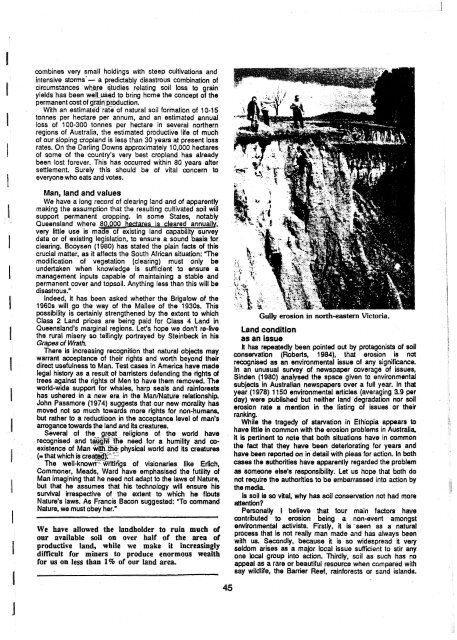soil-conservation-people-religion-and-land.pdf - South West NRM
soil-conservation-people-religion-and-land.pdf - South West NRM
soil-conservation-people-religion-and-land.pdf - South West NRM
Create successful ePaper yourself
Turn your PDF publications into a flip-book with our unique Google optimized e-Paper software.
combines very small holdings with steep cultivations <strong>and</strong><br />
intensive storms'- a predictably disastrous combination of<br />
circumstances whate studies relating <strong>soil</strong> loss to grain<br />
yields has been weR to bring home the concept of the<br />
permanent cast of gr;liirrprixluction.<br />
With an estimated rate' of natural <strong>soil</strong> formation of 10-15<br />
tonnes per hectare per annum, <strong>and</strong> an estimated annual<br />
loss of 100-300 tonnes per hectare in several northern<br />
regions of Australia, the estimated productive life of much<br />
of our sloping cropl<strong>and</strong> is less than 30 years at present loss<br />
rates. On the Darling Downs approximately 10,000 hectares<br />
of some of the country's very best cropl<strong>and</strong> has already<br />
been lost forever. This has occurred within 80 years after<br />
settlement. Surely this should be of vital concern to<br />
everyone who eats <strong>and</strong> votes.<br />
Man, l<strong>and</strong> <strong>and</strong> values<br />
We have a long record of clearing l<strong>and</strong> <strong>and</strong> of apparently<br />
making the assumption that the resulting cultivated <strong>soil</strong> will<br />
support permanent cropping. In some States, notably<br />
Queensl<strong>and</strong> where<br />
very little use is m<br />
data or of existing I<br />
clearing. Booysen (1980) has stated the plain facts of this<br />
crucial matter, as it affects the <strong>South</strong> African situation: "The<br />
modification of vegetation (clearing) must only be<br />
undertaken when knowledge is sufficient to ensure a<br />
management inputs capable of maintaining a stable <strong>and</strong><br />
permanent cover <strong>and</strong> top<strong>soil</strong>. Anything less than this will be<br />
disastrous."<br />
Indeed, it has been asked whether the Brigalow of the<br />
1960s will go the way of the Mallee of the 1930s. This<br />
possibility is certainly strengthened by the extent to which<br />
Class 2 L<strong>and</strong> prices are being paid for Class 4 L<strong>and</strong> in<br />
Queensl<strong>and</strong>'s marginal regions. Let's hope we don't re-live<br />
the rural misery so tellingly portrayed by Steinbeck in his<br />
Grapes of Wrath.<br />
There is increasing recognition that natural objects may<br />
warrant acceptance of their rights <strong>and</strong> worth beyond their<br />
direct usefulness to Man. Test cases in America have made<br />
legal history as a result of barristers defending the rights of<br />
trees against the rights of Men to have them removed. The<br />
world-wide support for whales, harp seals <strong>and</strong> rainforests<br />
has ushered in a new era in the Manmature relationship.<br />
John Passmore (1974) suggests that our new morality has<br />
moved not so much towards more rights for non-humans,<br />
but rather to a reductioon in the acceptance level of man's<br />
arrogance towards the l<strong>and</strong> <strong>and</strong> its creatures.<br />
Several of the_- gmat <strong>religion</strong>s of the world have<br />
recognised <strong>and</strong> taifme need for a humility <strong>and</strong> coexistence<br />
of Man iufi-' physical world <strong>and</strong> its creatures<br />
(= that which is crea&@?Lr<br />
The well-knowrfZwXTngs of visionaries like Erlich,<br />
Commoner. Meads, Ward have emphasised the futility of<br />
Man imagining that he need not adapt to the laws of Nature,<br />
but that he assumes that his technology will ensure his<br />
survival irrespective of the extent to which he flouts<br />
Nature's laws. As Francis Bacon suggested: "To comm<strong>and</strong><br />
Nature, we must obey her."<br />
We have allowed the l<strong>and</strong>holder to ruin much of<br />
our available <strong>soil</strong> on over half of the area of<br />
productive l<strong>and</strong>, while we make it increasingly<br />
difficult for miners to produce enormous wealth<br />
for us on less than 1% of our l<strong>and</strong> area.<br />
Gully erosion in north-eastern Victoria.<br />
L<strong>and</strong> condition<br />
as an issue<br />
It has repeatedly been pointed out by protagonists of <strong>soil</strong><br />
<strong>conservation</strong> (Roberts, 1984), that erosion is not<br />
recognised as an environmental issue of any significance.<br />
in an unusual survey of newspaper coverage of issues,<br />
Sinden (1980) analysed the space given to environmental<br />
subjects in Australian newspapers over a full year. In that<br />
year (1 978) 1150 environmental articles (averaging 3.9 per<br />
day) were published but neither l<strong>and</strong> degradation nor <strong>soil</strong><br />
erosion rate a mention in the listing of issues or their<br />
rankiig.<br />
While the tragedy of starvation in Ethiopia appears to<br />
have little in common with the erosion problems in Australia,<br />
it is pertinent to note that both situations have in common<br />
the fact that they have been deteriorating for years <strong>and</strong><br />
have been reported on in detail with pleas for action. In both<br />
cases the authorities have apparently regarded the problem<br />
as someone else's responsibility. Let us hope that both do<br />
not require the authorities to be embarrassed into action by<br />
the media.<br />
Is <strong>soil</strong> is so vital, why has <strong>soil</strong> <strong>conservation</strong> not had more<br />
attention?<br />
Personally I believe that four main factors have<br />
contributed to erosion being a non-event amongst<br />
environmental activists. Firstly, it is -seen as a natural<br />
process that is not really man made <strong>and</strong> has always been<br />
with us. Secondly, because it is so widespread it very<br />
seldom arises as a major local issue sufficient to stir any<br />
one local group into action. Thirdly, <strong>soil</strong> as such has no<br />
appeal as a rare or beautiful resource when compared with<br />
say wildlife, the Barrier Reef, rainforests or s<strong>and</strong> isl<strong>and</strong>s.
















